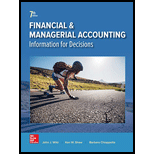
Concept explainers
Asset
Asset may be regarded as a resource for the person or entity which holds it with a specific economic value and the benefits derived from such asset are generally divided over the lifespan of such asset .Also, they are held to reap some future benefits on account of pooling the funds at present. An asset may be in tangible or intangible form depending upon the nature of asset.
Equity
An ownership interest in any kind of security or it may also be regarded as the difference value of the assets held and liabilities against the said assets. Also, in the financial statement of the company the funds contributed by the owners and any of the retained or ploughed back earnings (or losses) are regarded as shareholder's equity.
Liability
A liability may be regarded as the burden or it depicts the obligatory aspect related to a transaction and that it is to be fulfilled in the near future. They mainly form part of the financial statements so that the end users may analyze the current standing of the entity in terms of its liabilities against the possession of its assets.
To prepare:
Want to see the full answer?
Check out a sample textbook solution
Chapter 2 Solutions
Financial and Managerial Accounting
- Can you explain the correct approach to solve this general accounting question?arrow_forwardPlease provide the correct answer to this general accounting problem using valid calculations.arrow_forwardPlease provide the accurate answer to this general accounting problem using appropriate methods.arrow_forward
- I need help with this general accounting problem using proper accounting guidelines.arrow_forwardPlease provide the answer to this general accounting question with proper steps.arrow_forwardAccounting 12 Could an expert provide a brief summary highlighting one unique feature of the app, recommend it to Sadie—who wants to avoid payroll hassles—and suggest it as she plans to hire employees to extend her dog grooming salon hours? Thank you,arrow_forward
- Required information Skip to question [The following information applies to the questions displayed below.]Reba Dixon is a fifth-grade school teacher who earned a salary of $38,000 in 2021. She is 45 years old and has been divorced for four years. She receives $1,200 of alimony payments each month from her former husband (divorced in 2016). Reba also rents out a small apartment building. This year Reba received $50,000 of rental payments from tenants and she incurred $19,500 of expenses associated with the rental.Reba and her daughter Heather (20 years old at the end of the year) moved to Georgia in January of this year. Reba provides more than one-half of Heather’s support. They had been living in Colorado for the past 15 years, but ever since her divorce, Reba has been wanting to move back to Georgia to be closer to her family. Luckily, last December, a teaching position opened up and Reba and Heather decided to make the move. Reba paid a moving company $2,010 to move their…arrow_forwardCan you solve this general accounting question with accurate accounting calculations?arrow_forwardPlease explain the correct approach for solving this general accounting question.arrow_forward

 AccountingAccountingISBN:9781337272094Author:WARREN, Carl S., Reeve, James M., Duchac, Jonathan E.Publisher:Cengage Learning,
AccountingAccountingISBN:9781337272094Author:WARREN, Carl S., Reeve, James M., Duchac, Jonathan E.Publisher:Cengage Learning, Accounting Information SystemsAccountingISBN:9781337619202Author:Hall, James A.Publisher:Cengage Learning,
Accounting Information SystemsAccountingISBN:9781337619202Author:Hall, James A.Publisher:Cengage Learning, Horngren's Cost Accounting: A Managerial Emphasis...AccountingISBN:9780134475585Author:Srikant M. Datar, Madhav V. RajanPublisher:PEARSON
Horngren's Cost Accounting: A Managerial Emphasis...AccountingISBN:9780134475585Author:Srikant M. Datar, Madhav V. RajanPublisher:PEARSON Intermediate AccountingAccountingISBN:9781259722660Author:J. David Spiceland, Mark W. Nelson, Wayne M ThomasPublisher:McGraw-Hill Education
Intermediate AccountingAccountingISBN:9781259722660Author:J. David Spiceland, Mark W. Nelson, Wayne M ThomasPublisher:McGraw-Hill Education Financial and Managerial AccountingAccountingISBN:9781259726705Author:John J Wild, Ken W. Shaw, Barbara Chiappetta Fundamental Accounting PrinciplesPublisher:McGraw-Hill Education
Financial and Managerial AccountingAccountingISBN:9781259726705Author:John J Wild, Ken W. Shaw, Barbara Chiappetta Fundamental Accounting PrinciplesPublisher:McGraw-Hill Education





